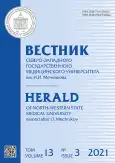Estimating possibility of applying the modified cumulative illness rating scale (CIRS-Obs) for predicting postpartum infections and antimicrobial resistance
- Authors: Korobkov N.A.1,2, Bakulina N.V.1, Repina M.A.1
-
Affiliations:
- North-Western State Medical University nаmed after I.I. Mechnikov
- Kirov Military Medical Academy
- Issue: Vol 13, No 3 (2021)
- Pages: 53-62
- Section: Original study article
- URL: https://journals.rcsi.science/vszgmu/article/view/77927
- DOI: https://doi.org/10.17816/mechnikov77927
- ID: 77927
Cite item
Abstract
BACKGROUND: In obstetrics, there are no systems or scales for assessing somatic burden, predicting and choosing empirical antibiotic therapy in postpartum (postoperative) pyoinflammatory complications.
AIM: The given research aims to assess the reliability and validity of the Cumulative Illness Rating Scale for Obstetrics (CIRS-Obs), which has been firstly modified for obstetric patients. The study is based on the inclusion of additional variables that may be used as highly informative predictors of the development of infectious complications resistant to antibiotics following caesarean section to assess the prognosis.
MATERIALS AND METHODS: A retrospective study of 406 clinical records of obstetric patients suffering endometritis following caesarean section and admitted to the Gynecology department of the Mariinskaya Municipal Hospital has been carried out during the period from September 2008 to September 2020. Multivariate regression analysis allowed to establish a number of indicators characterized by a high predictive value in relation to the unfavorable course of postpartum infections and the isolation of multidrug-resistant pathogens in patients with aggravated somatic status. The most significant factors have been included in the variant of the cumulative comorbidity index (CIRS-Obs), which was firstly modified by the authors for obstetric patients.
RESULTS: The most significant predictors associated with a high risk of isolating resistant and multidrug-resistant pathogens in the examined patients suffering endometritis include CIRS score ≥4 points, an emergency caesarean section in combination with a prolonged labor and a period without amniotic fluid, antibiotic therapy in the third trimester of pregnancy, as well as previous hospitalizations during pregnancy/invasive procedures or operations.
CONCLUSIONS: The CIRS-Obs scale modified for obstetric patients by including highly informative predictors and developed to assess the risk of isolating resistant and multi-resistant pathogens in obstetric patients suffering endometritis following cesarean section in terms of a patient’s somatic status, antibiotic therapy, the category of urgency and conditions of the operation allows to increase the reliability of the prognosis to make efficient therapeutic decisions.
Full Text
##article.viewOnOriginalSite##About the authors
Nikolay A. Korobkov
North-Western State Medical University nаmed after I.I. Mechnikov; Kirov Military Medical Academy
Email: nikolai_korobkov@mail.ru
ORCID iD: 0000-0001-7279-2535
SPIN-code: 4191-3581
MD, Cand. Sci. (Med.)
Russian Federation, 41 Kirochnaya St., Saint Petersburg, 191015; Saint PetersburgNatalya V. Bakulina
North-Western State Medical University nаmed after I.I. Mechnikov
Email: nv_bakulina@mail.ru
ORCID iD: 0000-0003-4075-4096
SPIN-code: 9503-8950
MD, Dr. Sci. (Med.)
Russian Federation, 41 Kirochnaya St., Saint Petersburg, 191015Margarita A. Repina
North-Western State Medical University nаmed after I.I. Mechnikov
Author for correspondence.
Email: marepina@inbox.ru
Scopus Author ID: 496280
MD, Dr. Sci. (Med.), Professor, Honoured Science Worker
Russian Federation, 41 Kirochnaya St., Saint Petersburg, 191015References
- Fein A, Wen T, D’Alton M, et al. Risk factors and temporality for postpartum infection readmissions. Am J Obstet Gynecol. 2019;220(1):419–411. doi: 10.1016/j.ajog.2018.11.640
- Leonard SA, Main EK, Carmichael SL. The contribution of maternal characteristics and cesarean delivery to an increasing trend of severe maternal morbidity. BMC Pregnancy Childbirth. 2019;19(1):16–22. doi: 10.1186/s12884-018-2169-3
- Kuklina EV, Meikle SF, Jamieson DJ, et al. Severe obstetric morbidity in the United States: 1998–2005. Obstet Gynecol. 2009;113(2 Pt 1):293–299. doi: 10.1097/AOG.0b013e3181954e5b
- Knight M, Acosta C, Brocklehurst P, et al. Beyond maternal death: improving the quality of maternal care through national studies of ‘near-miss’ maternal morbidity. Programme grants for applied research. 2016;9(4):1–180. doi: 10.3310/pgfar04090
- Mulani MS, Kamble EE, Kumkar SN, et al. Emerging strategies to combat ESKAPE pathogens in the era of antimicrobial resistance: А review. Front Мicrobiol. 2019;10:539–545. doi: 10.3389/fmicb.2019.00539
- Adamyan LV, Artymuk NV, Belokrinickaya TE, et al. Septicheskie oslozhneniya v akusherstve: klinicheskie rekomendacii (protokol lecheniya). Ministerstvo zdravookhraneniya RF. Moscow; 2017. (In Russ.)
- Adamyan LV, Kan NE, Lomova NA, et al. Poslerodovyi endometrit: klinicheskie rekomendatsii. Ministerstvo zdravookhraneniya RF. Moscow; 2016. (In Russ.)
- Antimicrobial resistance [Internet]. WHO. 2019. Available from: https://www.who.int/activities/optimizing-selection-and-use-of-antimicrobial-medicines. Accessed: Sep 15, 2021.
- McGregor JC, Kim PW, Perencevich EN, et al. Utility of the Chronic Disease Score and Charlson Comorbidity Index as comorbidity measures for use in epidemiologic studies of antibiotic-resistant organisms. Am J Epidemiol. 2005;161(5):483–493. doi: 10.1093/aje/kwi068
- Somerville NJ, Nielsen TC, Harvey E, et al. Obstetric comorbidity and severe maternal morbidity among massachusetts delivery hospitalizations, 1998–2013. Matern Child Health J. 2019;23(9):1152–1158. doi: 10.1007/s10995-019-02796-3
- Prikaz Minzdrava Rossii ot 01.11.2012 No. 572n “Ob utverzhdenii poryadka okazaniya meditsinskoy pomoshchi po profilyu “akusherstvo i ginekologiya (za isklyucheniyem ispol’zovaniya VRT)” [Internet]. Spravochnaya pravovaya sistema “Konsul’tantPlyus”. Available from: http://www.consultant.ru. Accessed: Sep 15, 2021. (In Russ.)
Supplementary files












